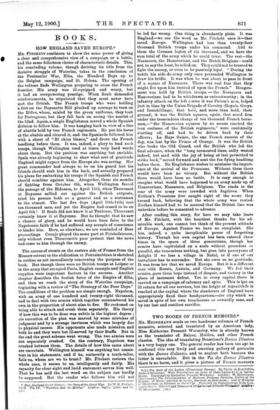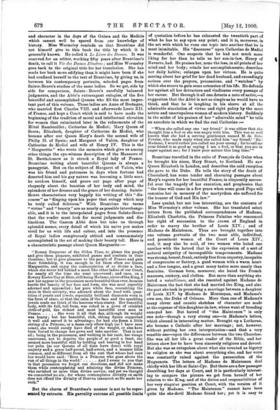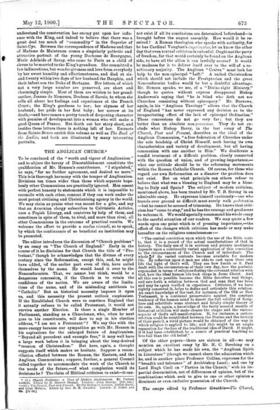TWO BOOKS OF FRENCH MEMOIRS.*
Ma. HEINEMANN sends us two handsome volumes of French memoirs, selected and translated by an American lady, Miss Katherine Prescott Wormeley, who is already known as the translator of Balza°, Moliere, and other French classics. The idea of translating Brantome's Dames Illustres is a very happy one. The general reader has been too apt to confound this very lively and amusing gallery of portraits with the Dames &lactates, and to neglect both because the latter is unreadable. But in the Vie des Dames Illustres there is no harm, and it gives a picture of French manners • (1.) The Book of the Ladies (Illustrious Dames). By Pierre de Bourdeilles, Abbe of BrantOme. With Elucidations on some of these Ladles by C.-A. Sainte- Betwe. Translated by Katherine Prescott Wormeley. London : W. Heinemann. [21s.]—(2.) The Correspondence of Madame, Princess Palatine, Mother of the Regent ; of Marie Adelaide de Savoie, Duchesse de Bourgogne ; and of Madame (le.Maintenon, in &Whorl. to Saint-Cyr. Preceded by Introductions fravi.:4. SainM-Benve. Selected and Tramlated by'Hatherind PrMott Worsucler. u W. liehiealann. [s.] . . . . .
and character in the days of the Guises and the Medicis which cannot well be spared from our knowledge of history. Miss Wormeley reminds us that Brantome did not himself give to this book the title by which it is generally known. He called it Le Livre des Dames. It was reserved for an editor, working fifty years after Brantome's death, to call it Vie des Dames Illustres ; and Miss Wormeley goes back to the original title for her translation. She has made her book more edifying than it might have been if she had confined herself to the text of BrantOme, by giving us, in between his contemporary portraits, selected pages from Sainte-Benve's studies of the same ladies. So we get, side by side for comparison, Sainte - Beuve's caref ally balanced judgments, and the Abbe's extravagant eulogies, of the five beautiful and accomplished Queens who fill the most impor- tant part of this volume. These ladies are Anne of Bretagne, who married first Charles VIII. and afterwards Louis XII. of France, and kept a Court which is said to have made the beginning of the tradition of moral and intellectual elevation for women that culminated later in the refinements of the Hotel Rambouillet ; Catherine de Medici; Mary Queen of Scots; Elizabeth, daughter of Catherine de Medici, who became after our Queen Mary's death the second wife of Philip II. of Spain ; and Margaret of Valois, daughter of Catherine de Medici and wife of Henry IV. This is the " Marguerite " who wrote the memoirs which give us among other things the eye-witness description of the Massacre of St. Bartholomew as it struck a Royal lady of France. Brantome writing about beautiful Queens is always a panegyrist. But on the subject of Margaret of Valois, who was his friend and patroness in days when fortune had deserted him and his gay nature was becoming a little sour, he outdoes himself, and pours out page after page of rhapsody about the beauties of her body and mind, the splendour of her dresses and the grace of her dancing. Sainte- Beuve characterises very happily his writing of this " dis- course" as " flinging upon his paper that eulogy which may be truly called delirious." With Brantome the terms " virtue " and " beauty" are as nearly as possible interchange- able, and it is to the interpolated pages from Sainte-Beuve that the reader must look for moral judgments and dis- tinctions. The Gascon Abbe does but take us through splendid scenes, every detail of which his naive pen makes vivid for us with life and colour, and into the presence of Royal ladies sumptuously attired and consummately accomplished in the art of making their beauty tell. Here is
a characteristic passage about Queen Marguerite :— " Roman Emperors of the Olden Time, to please the people and give them pleasure, exhibited games and combats in their theatres ; but to give pleasure to the people of France and gain their friendship, it was enough to let them often see Queen Marguerite, and enjoy the contemplation of so divine a face, which she never bid behind a mask like other ladies of our Court, for nearly all the time she went uncovered ; and once, on a flowery Easter Day at Blois, still being Madame, sister of the King, I saw her appear in the procession more beautiful than ever, because beside the beauty of her face and form, she was most superbly adorned and appapelled ; her pure white face, resembling the skies in their serenity, was adorned about the head with quan- tities of pearls and jewels, especially brilliant diamonds worn in the form of stars, so that the calm of the face and the sparkling jewels made me think of the heavens when starry. Her beautiful body, with its full, tall form, was robed in a gown of crinkled cloth-of-gold, the richest and most beautiful ever seen in France She wore it all that day, although its weight was heavy ; but her beautiful, rich, strong figure supported it well and served it to advantage; for had she Ibsen a little shrimp of a Princess, or a dame only elbow-high (as I have seen some), she would surely have died of the weight, or else have been forced to change her gown and take another. That is not all ; being in the procession, and walking in her rank, her visage uncovered, not to deprive the people of so good a feast, she seemed more beautiful still by holding and bearing in her hand her palm (as our Queens of all time have done) with royal majesty and a grace half-proud, half-sweet, and a manner little common, and so different from all the rest that whoso had seen her would have said : 'Here is a Princess who goes above the run of all things in the world.' And I swear to you that in that procession we forgot our devotions, and did not make them while contemplating and admiring the divine Princess, who ravished us more than divine service, and yet we thought we committed no sin ; for whoso contemplates divinity on earth does not offend the divinity of Heaven inasmuch as He made her finch."
But, the charm of Brantome's manner is not to be repre- sented by extracts. His garrulity outruns all possible limits
of quotation before he has exhausted the twentieth part of what he has to say upon any point; and it is, moreover, in the art with which he runs one topic into another that he is most inimitable. His "discourse" upon Catherine de Medici is wonderful. One suspects that be had not much more liking for her than he tells us her son-in-law, Henry of Navarre, had. He praises her, none the less, in all points of her
mind and her body ; retails her accomplishments; describes her daily habits; enlarges upon her virtues. He is quite
moving about her grief for her dead husband, and exceedingly serious over the prayers, processions, and " watches " by which she strove to gain some extension of his life. He defends her against all her detractors and vindicates every passage of her career. But through it all one detects a note of satire,—a suggestion that the Abb6 is not so simple as he would have us think, and that he is laughing in his sleeve at all the admirable simulation of virtue and right policy by the most astute and unscrupulous woman of modern history. Suddenly in the midst of his praises of her "admirable mind" he tells an anecdote in which we find the real Catherine :-
" When she called any one my friend' it was either that she thought him a fool or she was angry with him. This was so well known that she had a serving gentleman named M. de Lois- Fevrier, who made reply when she called him my friend," Ha ! Madame, I would rather you called me your enemy ; for to call me your friend is as good as saying I am a fool, or that you are in anger against me ; for I know your nature this long time."
Brantome travelled in the suite of Francois de Guise when he brought his niece, Mary Stuart, to Scotland. He saw Queen Elizabeth in London, and describes the cold reception she gave to the Dnke. He tells the story of the death of Chastelard, has some tender and charming passages about Mary's regrets for her beautiful France, is eloquently sorrow- ful over the tragedy of her execution, and prophesies that " the time will come in a few years when some good Pope will canonize her in memory of the martyrdom she suffered for the honour of God and His law."
Less quaint, but not less interesting, are the contents of Miss Wormeley's other volume. She has translated select letters from the published correspondences of Madame, Elizabeth Charlotte, the Princess Palatine who renounced her right of succession to the crown of England in order to marry the brother of Louis XIV. ; and of Madame de Maintenon. Thus are brought together into one volume portraits of the two most able, individual, and prominent women of the Court of Louis XIV., and, it may also be said, of two women who hated one another with the hatred that is the expression of a sort of natural antipathy of incompatible temperaments. Madame was strong, honest, f rank, entirely free from coquetry, incapable of compromise or flattery, a good woman with a warm heart and a free tongue, and a great many tastes more manly than feminine. German born, moreover, she hated the French manners, cookery, and clothes. But more than anything she hated a misalliance, and she resented against Madame de Maintenon the fact that she had married the King, and also the part she took in promoting a marriage between a daughter of Louis XIV. by Madame de Montespan, and Madame's
own eon, the Duke of Orleans. More than one of Madame's many clever and caustic sketches of character are made at the expense of this daughter-in-law, whose want of breeding annoyed her. Bat hatred of "the Maintenon" is only
one note—though a very strong one—in Madame's letters, which abound in interesting matter. Brought up a Lutheran, she became a Catholic after her marriage ; not, however, without putting her own interpretation—and that a very sensible one—upon the differences between the two Churches. She was all her life a great reader of the Bible, and her letters show her to have been sincerely religions and devout. But she was as outspoken about what she counted as bigotry in religion as she was about everything else, and her voice was constantly raised against the persecution of the Huguenots. The letters of Madame de Maintenon deal chiefly with her life at Saint-Cyr. But there are a few passages describing her days at Court, and it is particularly interest-
ing to compare the picture we get from herself of her relation to the King, and of the duties and responsibilities of
her very singular position at Court, with the version of it given by Madame. " The Maintenon" cannot have been
quite the she-devil Madame found her ; yet it is easy to understand the construction her enemy put upon her influ- ence with the King, and indeed to believe that there was a great deal too much of " commodity " in the Superior of Saint-Cyr. Between the correspondence of Madame and that of Madame de Maintenon comes a singularly pathetic and attractive portrait of the young Dachesse de Bourgogne, Marie Adelaide of Savoy, who came to Paris as a child of eleven to be married to the King's grandson. She committed a few indiscretions, but won forgiveness and love from everybody by her sweet humility and affectionatenesa, and died at six- and-twenty within two days of her husband the Dauphin, and their infant son the Duke of Bretagne. Her letters, of which not a very large number are preserved, are short and charmingly simple. Most of them are written to her grand- mother, Jeanne de Nemours, Duchess of Savoie, to whom she tells all about her feelings and experiences at the French Court ; the King's goodness to her; her shyness of her husband; her pride in her first baby ; her sorrow at its death,—and here comes a pretty touch of deepening character with promise of development into a woman who will make a good Queen of France. But death cut her story short, and besides these letters there is nothing left of her. Extracts from Sainte-Bettye enrich this volume as well as The Book of the Ladies, and both are illustrated by many interesting portraits.








































 Previous page
Previous page